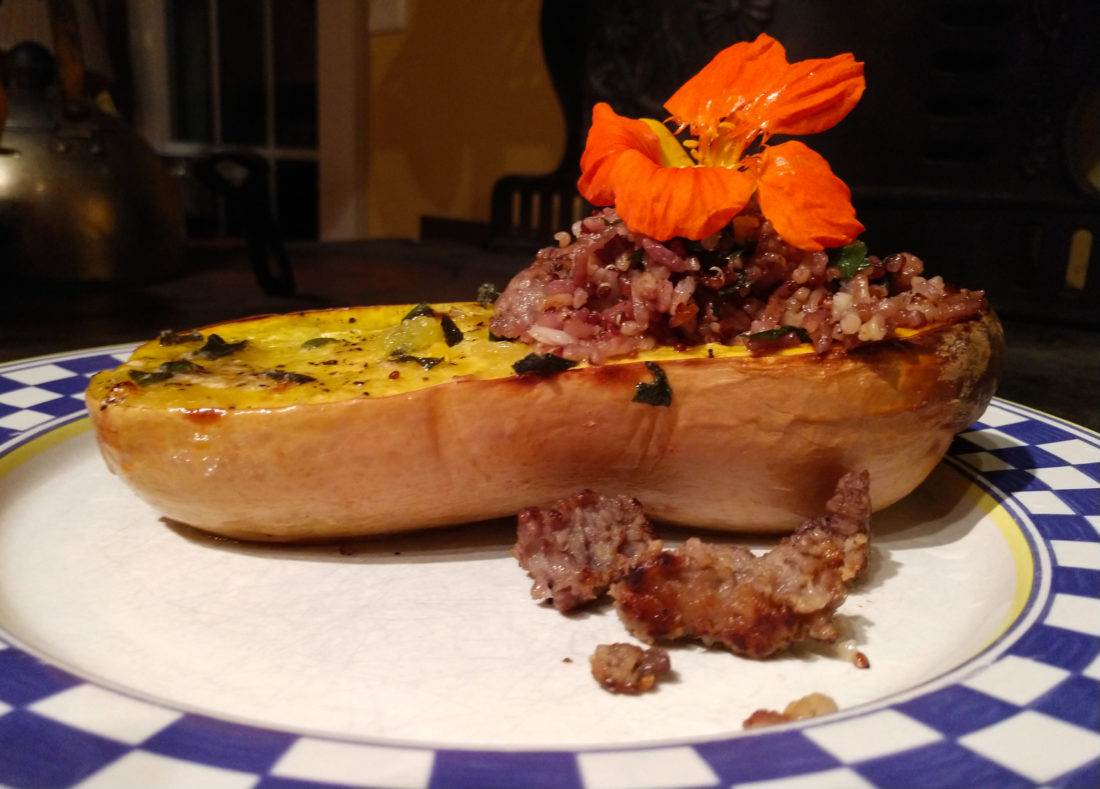Squash (Cucurbitaceae) can be found at almost every farmers market across the country as the autumn season ripens into winter. Ubiquitous in nature (how many of you have stuffed your neighbors’ mailboxes with zucchini when an overabundance graced your garden?), it wears many robes and serves a multitude of roles across cultures.
Originating in the Americas, the word squash comes from the Narragansett people (a tribe of the Algonquins), to whom “askutasquash” means “green thing eaten raw,” according to the Library of Congress. Botanically a fruit, it is one of the oldest-known cultivated crops.
The Cherokee often paid homage to the Three Sisters (corn, beans and squash), which they planted hand in hand. The corn served as a support to the climbing beans and squash provided shade to the roots of both its sisters, while also keeping weeds from going rampant. As the first of the trio to be domesticated (at least as far back as 10,000 years ago), squash can be considered the eldest of the sisters.
Nutritionally, squash is a good source of minerals, carotene and vitamin A. They also contain healthy amounts of vitamins B, B6, C and E, as well as niacin, riboflavin, potassium, iron and more. Since corn and beans are complementary proteins, the combination of the Three Sisters in a daily diet provides most of the essential nutrients for survival. Together, corn, beans and squash contain complex carbohydrates, essential fatty acids and all nine essential amino acids.
As a bonus, all parts of the fruit can be used. The hull of the winter squash can be hollowed out and used as a dipper, a bowl, or as a percussion instrument when filled with dried beans or other seeds. The flesh can be baked, boiled, fried, puréed or eaten raw. The seeds can be roasted, salted and served as a snack or used to garnish whatever dish is confected with the flesh.
Squash stems, if cut right, can be played like a reed instrument. And of course, the male blossoms can be stuffed and fried for a delicate appetizer. (Female blossoms turn into fruit, so be sure to leave them on the vine!)
There are five domesticated species of squash, including both summer and winter varieties. Common names include the traditional buttercup, butternut, acorn, candy roaster, pumpkin, cushaw, spaghetti, zucchini, yellow crookneck, delicata, pattypan, cousa, chayote, hubbard, kabocha, ambercup, banana, carnival, fairytale, gold nugget, sweet dumpling and turban.
As part of the seed-saving tradition, heirloom squash seeds can now be found in seed banks in public libraries. A tradition begun in 2014 by Jeff Quattrone, seed banks serve as buffers to seed privatization by multinational agrichemical corporations. Available locally at both the Black Mountain Public Library and UNCA’s Ramsey Library, anyone with a North Carolina public library card can borrow seeds from a variety of heirlooms, and borrowers are encouraged to return seeds to the bank once their crops have been harvested.
A plentitude of recipes can carry us through the winter. There’s squash soup, chowder, bisque, pizza, pie, lasagna, ravioli, slaw and gratin; baked, roasted, candied, stuffed and pickled squash; squash as an ingredient in chowchow or succotash. And of course, there is zucchini bread, pumpkin bread, chocolate zucchini cake, squash pancakes — the list goes on.
The accompanying recipe is easy and satisfying as you cozy up to a wood fire and contemplate lengthening winter nights.
Baked butternut squash with sage and sausage
In the long list of recipes that can conveniently incorporate leftovers while masquerading as an entirely new dish, you can now add autumn squash to your repertoire. Different varieties have varying levels of sweetness, so adjust your fillings accordingly. Try adding chestnuts; shredded, sautéed greens; pine nuts; mushrooms or Brussels sprouts — whatever you have left to repurpose — giving the items a new life and yourself, as the chef, carte blanche (permission to do anything!).
½ butternut squash per person, sliced lengthwise
1-2 tablespoons butter per half squash
Diced bell peppers, if handy
One or two onions or shallots
Leftover breakfast sausage
Leftover rice
Handful of fresh sage, sliced in thin ribbons
Dash of red pepper flakes
Salt and pepper to taste
Wash squash and slice lengthwise, removing seeds and pulp. (Roast seeds with olive oil and salt and use as an appetizer or as a garnish for your dish.) Place squash halves upside down on a baking sheet and bake in a 400-degree oven until close to done. Flip over so the cut side is facing up and brush with butter. Sprinkle with salt, pepper and fresh sage.
Meanwhile, sauté diced onions and shallots until translucent and add the breakfast sausage (and peppers, too, if handy). Fill squash cavity with the mixture and bake until everything is slightly caramelized. Enjoy with a Côtes du Rhône, or if you are a white wine aficionado, with an Alsatian Gewürztraminer.
Chef, musician and author, Susi Gott Séguret orchestrates a variety of culinary experiences including her flagship Seasonal School of Culinary Arts, the Asheville Truffle Experience and the Appalachian Culinary Experience. For more, see schoolofculinaryarts.org.





Before you comment
The comments section is here to provide a platform for civil dialogue on the issues we face together as a local community. Xpress is committed to offering this platform for all voices, but when the tone of the discussion gets nasty or strays off topic, we believe many people choose not to participate. Xpress editors are determined to moderate comments to ensure a constructive interchange is maintained. All comments judged not to be in keeping with the spirit of civil discourse will be removed and repeat violators will be banned. See here for our terms of service. Thank you for being part of this effort to promote respectful discussion.